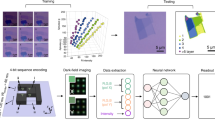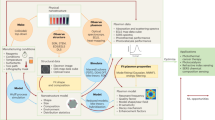Abstract
This study looks into the introduction of AI-driven electrochromic materials and devices into nanofabrication methods for use in ML-integrated environments. When exposed to an electric field, electrochromic materials experience reversible changes in optical properties due to dynamic optical modulation. Because of developments in AI-assisted design, optimization, and fabrication, advanced electrochromic devices with improved performance are now conceivable. The incorporation of AI-optimized electrochromic materials into nanofabrication operations and their application in ML-integrated systems are described, as well as their synthesis and characterization. Several test datasets revealed that the AI-driven strategy improved OME, Response Times, CE, and EE. These findings validate the importance of applying AI algorithms to guide material design, optimize production, and enable real-time adaptation for greater optical modulation and energy efficiency.






Similar content being viewed by others
References
Au, B.W.C., Chan, K.Y.: Effect of precursor solution stirring time on the electrochromic performance of tungsten oxide films. Surf. Eng. 36(1), 94–99 (2020)
Campbell, Z.S., Bateni, F., Volk, A.A., Abdel-Latif, K., Abolhasani, M.: Microfluidic synthesis of semiconductor materials: Toward accelerated materials development in flow. Part. Part. Syst. Charact. 37(12), 2000256 (2020)
Chaudhary, A., Pathak, D.K., Tanwar, M., Dash, R., Joshi, B., Keerthivasan, T., Kumar, R.: Hydrothermally grown nano-WO3 electrochromic film: structural and Raman spectroscopic study. Adv. Mater. Process. Technol. 8(1), 970–976 (2022)
Deepa, M., Srivastava, A.K., Sood, K.N., Agnihotry, S.A.: Nanostructured mesoporous tungsten oxide films with fast kinetics for electrochromic smart windows. Nanotechnology 17(10), 2625 (2006)
Demir, F., Keles, D., Karabag, A., Cirpan, A., Toppare, L.: A novel multi-electrochromic polymer based on selenophene and benzotriazole via electrochemical and chemical polymerization. J. Macromol. Sci. Part A 56(3), 197–205 (2019)
Dounis, A.I.: Machine intelligence in smart buildings. Energies 16(1), 22 (2022)
El Bachiri, A., Soussi, L., Karzazi, O., Louardi, A., Rmili, A., Erguig, H., El Idrissi, B.: Electrochromic and photoluminescence properties of cobalt oxide thin films prepared by spray pyrolysis. Spectrosc. Lett. 52(1), 66–73 (2019)
Hacioglu, S.O., Ataoglu, E., Hizalan, G., Depci, T., Cirpan, A., Toppare, L.: Thiadiazoloquinoxaline and benzodithiophene bearing polymers for electrochromic and organic photovoltaic applications. Phosphorus Sulfur Silicon Relat. Elem. 194(9), 937–946 (2019)
Hagita, K., Aoyagi, T., Abe, Y., Genda, S., Honda, T.: Deep learning-based estimation of Flory-Huggins parameter of A-B block copolymers from cross-sectional images of phase-separated structures. Sci. Rep. 11(1), 12322 (2021)
Huang, C., Dong, B., Lu, N., Yang, B., Gao, L., Tian, L., Chi, L.: A strategy for patterning conducting polymers using nanoimprint lithography and isotropic plasma etching. Small 5(5), 583–586 (2009)
Indhumathi, R., Amuthabala, K., Kiruthiga, G., Pandey, A.: Design of task scheduling and fault tolerance mechanism based on GWO algorithm for attaining better QoS in cloud system. Wirel. Pers. Commun. 128(4), 2811–2829 (2023)
Jensen, J., Hösel, M., Dyer, A.L., Krebs, F.C.: Development and manufacture of polymer-based electrochromic devices. Adv. Func. Mater. 25(14), 2073–2090 (2015)
Ko, I.J., Park, J.H., Kim, G.W., Lampande, R., Kwon, J.H.: An optically efficient full-color reflective display with an electrochromic device and color production units. J. Inf. Disp. 20(3), 155–160 (2019)
Lee, S., Kim, M.J., Lee, S.H., Jeong, S.H., Kwon, J.H., Jeong, J.K.: Boosting coloration efficiency in an electrochromic device using an ITO/Ag/ITO multilayered electrode and porous WO3 chromic layer. J. Inf. Disp. 23, 1–12 (2023)
Manikandan, R., Sara, S. B. V. J., Chaturvedi, A., Priscila, S. S., & Ramkumar, M. (2022). Sequential pattern mining on chemical bonding database in the bioinformatics field. In AIP Conference Proceedings (Vol. 2393, No. 1). AIP Publishing.
Raccuglia, P., Elbert, K.C., Adler, P.D., Falk, C., Wenny, M.B., Mollo, A., Norquist, A.J.: Machine-learning-assisted materials discovery using failed experiments. Nature 533(7601), 73–76 (2016)
Raj, F.I.: Implementation of machine learning techniques in unmanned aerial vehicle control and its various applications. In: Computational Intelligence for Unmanned Aerial Vehicles Communication Networks, pp. 17–33. Springer International Publishing, Cham (2022)
Selberg, J., Jafari, M., Mathews, J., Jia, M., Pansodtee, P., Dechiraju, H., Rolandi, M.: Machine learning-driven bioelectronics for closed-loop control of cells. Adv. Intell. Syst. 2(12), 2000140 (2020)
Surendiran, J., Theetchenya, S., Benson Mansingh, P.M., Sekar, G., Dhipa, M., Alene, A.: Segmentation of optic disc and cup using modified recurrent neural network. Bio Med Res. Int. 2022, 492536 (2022)
Tabor, D.P., Roch, L.M., Saikin, S.K., Kreisbeck, C., Sheberla, D., Montoya, J.H., Aspuru-Guzik, A.: Accelerating the discovery of materials for clean energy in the era of smart automation. Nat. Rev. Mater. 3(5), 5–20 (2018)
Weissman, D.: Heliotropic shading: Daylighting a rare books reading room with electrochromic glass and parametric analysis. LEUKOS 23, 1–24 (2023)
Xie, L., Zhao, S., Zhu, Y., Zhang, Q., Chang, T., Huang, A., Bao, S.: High performance and excellent stability of all-solid-state electrochromic devices based on a Li1.85AlOz ion conducting layer. ACS Sustain. Chem. Eng. 7(20), 17390–17396 (2019)
Zifang, X., Yujie, J., Can, G.: Based on the study on preparation and properties of Co (II) and La3+-doped TiO2 electrochromic film. Integr. Ferroelectr. 209(1), 58–67 (2020)
Funding
This work was funded by the Researchers Supporting Project No.(RSP2023R363), King Saud University, Riyadh, Saudi Arabia.
Author information
Authors and Affiliations
Contributions
K.M.P.: Investigation, methodology, writing—review & editing. A.S.: Conceptualization, formal analysis, writing—review & editing. K.T.: Conceptualization, formal analysis, writing—original draft. A.G.: Writing—review & editing. A.S.: Conceptualization, writing—review & editing. A.S.M.M.: Formal analysis, writing—review & editing. S.A.: Formal analysis, writing—review & editing.
Corresponding author
Ethics declarations
Conflict of interest
The authors declare no competing interests.
Additional information
Publisher's Note
Springer Nature remains neutral with regard to jurisdictional claims in published maps and institutional affiliations.
Rights and permissions
Springer Nature or its licensor (e.g. a society or other partner) holds exclusive rights to this article under a publishing agreement with the author(s) or other rightsholder(s); author self-archiving of the accepted manuscript version of this article is solely governed by the terms of such publishing agreement and applicable law.
About this article
Cite this article
Prasanna, K.M., Shukla, A., Tamizharasu, K. et al. AI-driven electro chromic materials and devices for nanofabrication in machine learning integrated environments. Opt Quant Electron 56, 15 (2024). https://doi.org/10.1007/s11082-023-05656-1
Received:
Accepted:
Published:
DOI: https://doi.org/10.1007/s11082-023-05656-1




